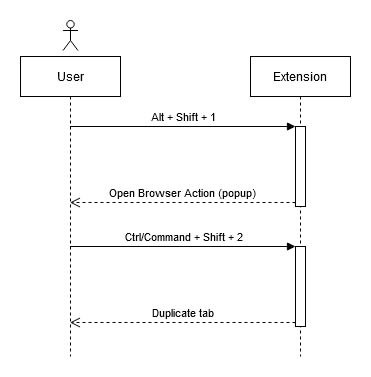An Interest In:
Web News this Week
- April 26, 2024
- April 25, 2024
- April 24, 2024
- April 23, 2024
- April 22, 2024
- April 21, 2024
- April 20, 2024
Adding shortcuts to your Chrome Extension
Last week I wrote an article explaining how to create a simple chrome extension. Today I'm going to add a new feature to the same extension we built last week: Keyboard shortcuts.
We will add two shortcuts: One to open the browser action we created in the previous article and one to duplicate the current tab. The shortcuts will be Alt + Shift + 1 and Ctrl/Command + Shift + 2.
Using these 2 examples, we will learn how to add different types of shortcuts to our extension.
Table of contents
Commands API
To create a keyboard shortcut for our extension, we must use the commands API. Through this API, we can define commands for our extension and bind them to keyboard shortcuts. When someone uses the shortcut, the command will be triggered, and the logic we added to the command will be executed.
Commands must be added to the manifest.json file along with their suggested keyboard shortcut. Multiple commands can be defined in the manifest.json. However, only 4 shortcuts can be suggested by our extension. The user can bind the other commands to a keyboard shortcut from the browser (chrome://extensions/shortcuts).
Available keys
Any keyboard shortcut must use eitherCtrl(Commandin Mac) orAltbut cannot include both.Shiftcan also be used.Other supported keys:
A-Z,0-9,Comma,Period,Home,End,PageUp,PageDown,Space,Insert,Delete, Arrow keys (Up,Down,Left,Right) and the Media Keys (MediaNextTrack,MediaPlayPause,MediaPrevTrack,MediaStop).Examples:
Ctrl + Shift + L,Alt + Shift + LCommand + ,Ctrl + Shift + 1
Keep in mind that you cannot use commands reserved by the browser, like Ctrl + T (which in Chrome opens a new tab).
The logic that should be executed once the user runs a command should be handled in a background script. I will explain more about this later.
Let's get coding
1. Define the commands in the manifest.json file
To define a command, we should use the commands property in our manifest.json file, like so:
{ "manifest_version": 2, "name": "Acho, where are we?", ... "commands": { "_execute_browser_action": { "suggested_key": { "default": "Alt+Shift+1" } }, "duplicate-tab": { "suggested_key": { "default": "Ctrl+Shift+2", "mac": "Command+Shift+2" }, "description": "Duplicates the currently active tab because... why not?" } }}In the previous code, we defined 2 different commands:
_execute_browser_action: This is a reserved command that will be handled by chrome directly. By defining it in ourmanifest.json, we are telling chrome to open our browser action when the user executes the shortcut. We do not need to handle the logic for this command ourselves.duplicate-tab: This is a custom command that our extension must handle manually. Notice that this command also includes adescription, which is not required for reserved commands (chrome just displays a default description that cannot be overridden).
2. Add a background script
To handle the logic for our duplicate-tab command, we will need a background script. Using this script, we will listen for the onCommand method and execute the appropriate logic.
About background scripts
Background scripts are used mainly to listen to events from the browser and trigger a reaction. These scripts will stay running while they perform their tasks after some event was fired, and then they will be unloaded.
To include our background script, we must modify our manifest.json file and define the script using the background property, like so:
{ "manifest_version": 2, "name": "Acho, where are we?", ... "background": { "scripts": [ "background.js" ], "persistent": false }}Finally, let's add a new file called background.js in our project's root.
3. Listen for the command event
For our command to be properly handled, we need to listen to the onCommand event in our background script and execute the appropriate logic once our command is called.
So we will listen to the event and call the duplicateTab function when the duplicate-tab command is called:
chrome.commands.onCommand.addListener(function (command) { switch (command) { case 'duplicate-tab': duplicateTab(); break; default: console.log(`Command ${command} not found`); }});/*** Gets the current active tab URL and opens a new tab with the same URL.*/function duplicateTab() { const query = { active: true, currentWindow: true }; chrome.tabs.query(query, (tabs) => { chrome.tabs.create({ url: tabs[0].url, active: false }); });}Notice that I did not include a
casefor the_execute_browser_actioncommand because, as we said before, that command is handled automatically by chrome.
Done!
Now when the user executes Alt + Shift + 1, the browser action will be open, and when they use the shortcut Ctrl/Command + Shift + 2, the current tab will be duplicated.
The repo
I'm keeping this repo updated with all my Chrome Extensions examples:
 pawap90 / acho-where-are-we
pawap90 / acho-where-are-we
Acho (a cute pup) tells you the title of the current page on your browser. A sample chrome extension.
Was this useful?
Let me know what you think about this article in the comments!
Original Link: https://dev.to/paulasantamaria/adding-shortcuts-to-your-chrome-extension-2i20
Dev To
 An online community for sharing and discovering great ideas, having debates, and making friends
An online community for sharing and discovering great ideas, having debates, and making friendsMore About this Source Visit Dev To


